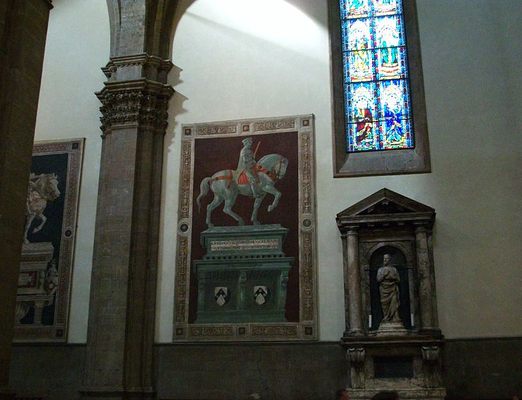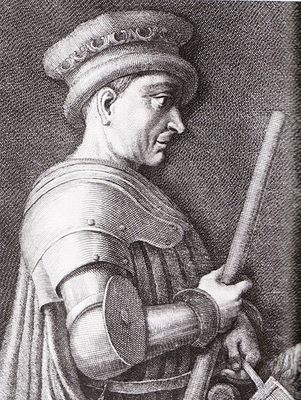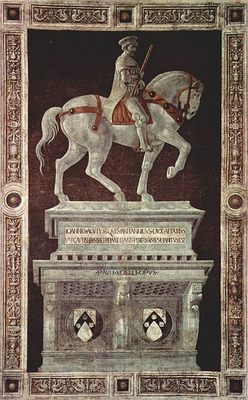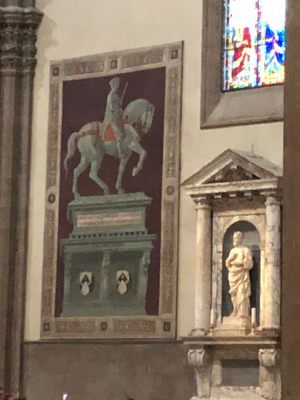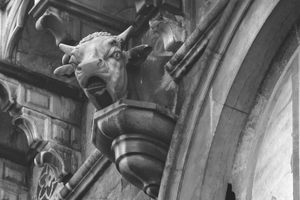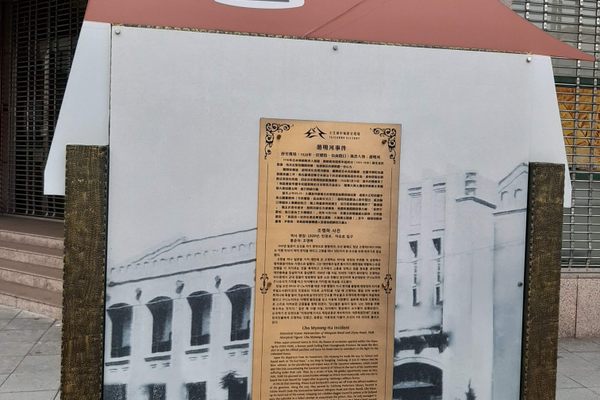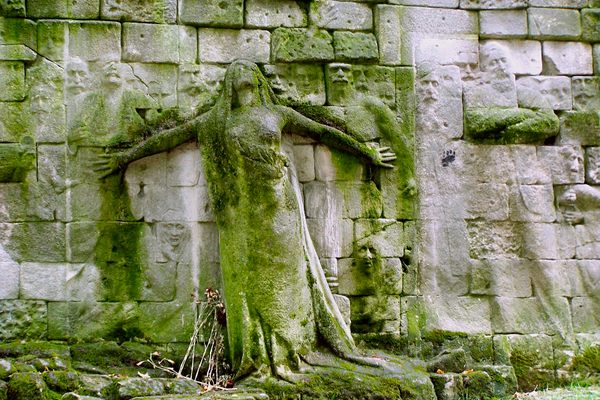About
A British interloper is memorialized in the Italian sanctuary of the Duomo, in Florence. The inscription under the huge fresco reads (translated), "John Hawkwood, British knight, most prudent leader of his age, and most expert in the art of war".
In May of 1364, he led some 10,000 men and 3000 horses and surrounded the walls of Florence in a month-long siege during which they burned surrounding farmlands and homes. Finally, his men were paid a fortune to leave. In July of that year he set out again against Florence, but suffered his first major defeat. This was the beginning of a path that led to being the hero of Florence.
The condottiero John Hawkwood was a veteran of the Hundred Years War, and a ruthless mercenary leader who commanded private armies of thousands, attacking cities in Italy on behalf of the highest bidder. He was known for his cunning and (relative) restraint. In the company of men even more bloodthirsty than him, he seemed a better businessman than most, often extracting enormous ransoms from cities under siege rather than going through the bother of sacking them.
Of course, in order to wield that kind of threatening power, you need a really deadly reputation, which he also had in spades.
Hawkwood rose to power during the lawless years of plague and corruption in Italy in the middle of the 14th century, famously called "the calamitous century" by scholar Barbara Tuchman. Not a country, but a hodge-podge of kingdoms, independent republics, and wealthy walled city states, there was endless bickering and grabs for land and power between them. With the pope up north in Avignon, whatever ability the Holy Roman Empire had to control events in the center of the peninsula disappeared. Enter the mercenaries.
The Hundred Years War started between France and England as a fight over the crown in 1328 came to a pause in 1360 due to a truce. It seemed the war had finally ended (it actually dragged on well into the next century). Out of work, thousands of English soldiers headed home, but others chose to stay and go into business for themselves.
These highly trained military men, their horses, their equipment, and their assorted hangers-on began to form their own private armies, known as "free companies", and went looking for work. Hawkwood first formed the Great Company, then later took over the White Company from another mercenary (basis for Sir Arthur Conan Doyle's book The White Company), and moved down into Italy. Over the years he fought against the pope, and for the pope, against the powerful Visconti of Milan, and then for them, eventually marrying a Visconti daughter. Finally he started moving around cities in Tuscany, and was employed by Pisa against their nearby enemy: Florence.
For twenty years after his 1364 siege of Florence and subsequent defeat he followed the money from city to city, finally coming into the employ of Florence in 1390. He died there 1394 and was regarded as a Florentine hero. Even before he died, the city was hatching plans for a grand statue to honor him, in the tradition of the Ancient Roman equestrian statues, then very much in vogue. Amidst dithering and plan changes, a first fresco was painted in the (still domeless) Duomo, while the statue plans were sorted out. By 1436 it seems all plans had been scrapped, and the well known painter Paolo Uccello was brought in to give the fresco a proper overhaul.
Uccello was best known for his detailed gothic style, and an obsession with perspective, so it is strange to note that when looking at the fresco the statue appears to be in line with the viewers eyeline, while the base of the horse statue is seen from slightly below. Uccello was asked to repaint his first version of the fresco, possibly to reduce the military stance of the first draft into a more parade-like stance, or possibly to adjust the perspective to make less of the horse's anatomy visible in the church.
The minimal coloring of the painting and the deathly pallor of the rider have led some to speculate that Hawkwood is here intended to be an allegory of Death, the fourth horseman mounted on his pale horse.
After his death, Richard II of England requested that his body be returned to England, but it is uncertain that it ever happened. He may still be interred in an unmarked spot under the floor of the Duomo, his original resting place.
If he was returned to England, he is most likely interred near the small carved memorial arch on the wall in the church in his hometown, St. Peters in Sible Hedingham, England.
Also in the Duomo is another, very similar painting of another condotierro, Niccolo da Tolentino, also by Uccello.
Related Tags
Flavors of Italy: Roman Carbonara, Florentine Steak & Venetian Cocktails
Savor local cuisine across Rome, Florence & Venice.
Book NowCommunity Contributors
Added By
Published
December 11, 2009
Sources
- <cite>The Devil
- <cite>Medieval Italy - An Encyclopedia, Volume 1</cite>, pages 488-490, Thomas E. Mussio
- http://en.wikipedia.org/wiki/Funerary_Monument_to_Sir_John_Hawkwood
- http://en.wikipedia.org/wiki/John_Hawkwood
- http://www.deremilitari.org/resources/articles/hawkwood.htm (chapter 42)
- http://www.wga.hu/frames-e.html?/html/u/uccello/3florenc/1hawkwoo.html
- http://www.paladins-of-chivalry.org.uk/hawkwood.php
- http://www.sacred-destinations.com/italy/florence-duomo
